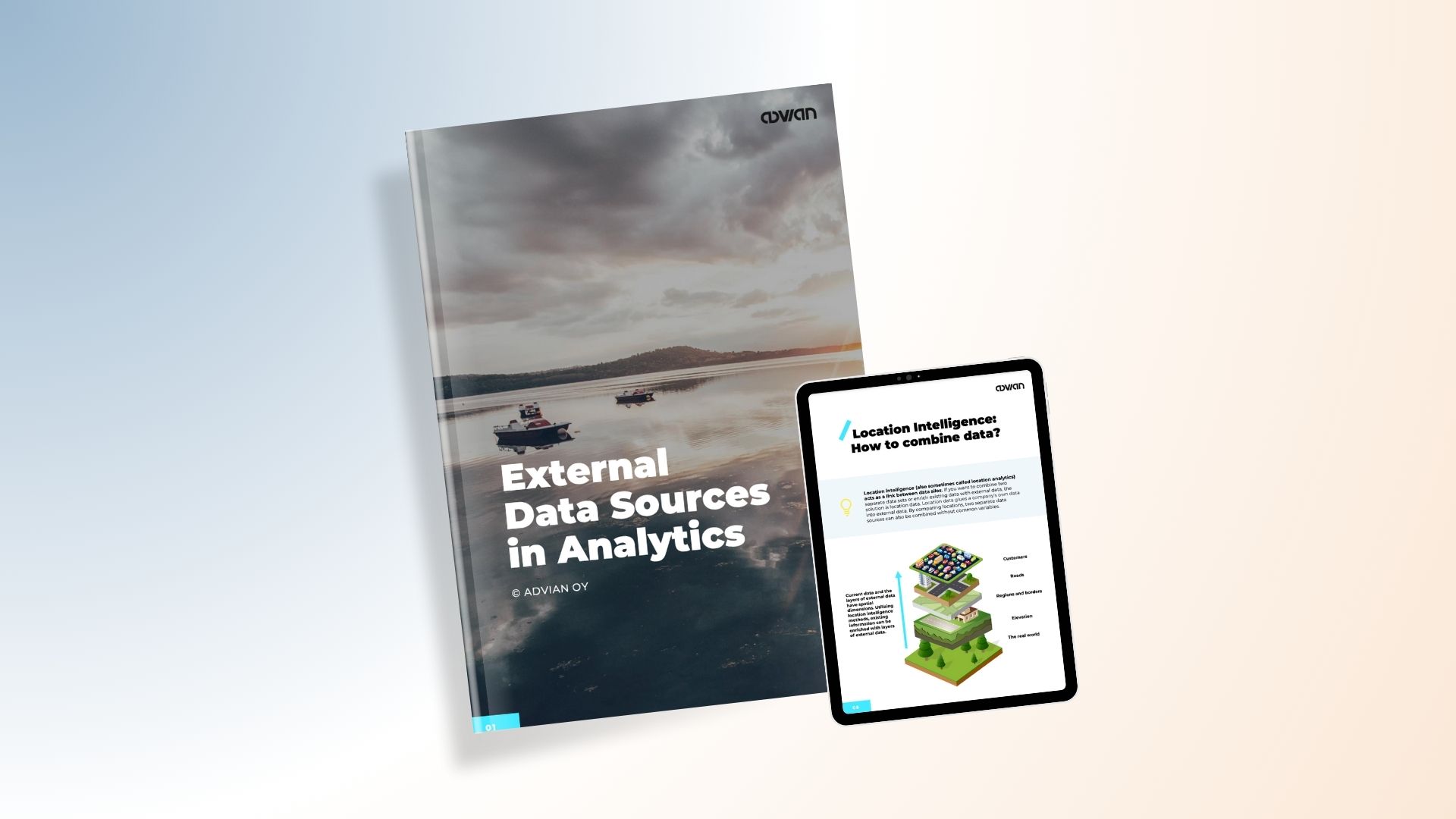Location data can be indicated as an address, coordinates, postal code, or as another known destination.
Location data alone is just a point on a map. However, there is a huge power in this small point of data. Location data is at its best when it collides with other data and is incorporated into the overall architecture. When location data is further processed in this way, we refer to location intelligence.
Location intelligence can be defined as advanced analytics that involves location data. Advanced analytics is all analytics that is more advanced than the traditional “looking in the rearview mirror” kind. Location intelligence can be directly translated into strategic or operational measures - and thus solve a wide range of business problems.
Geospatial data is information about an object whose location is known. Geospatial data is a set of data that can be associated with a specific location. Geospatial data analytics, or geoprocessing, on the other hand, usually refers to a form of analytics that is strongly based on visualization on a map and/or dashboards. Geospatial data analytics paints a good picture of the current situation, but it can’t predict the future.
Location intelligence is advanced analytics that is incorporated within the organization’s processes and services. Let's illustrate this difference with an example:
For example, a traditional geospatial data dashboard can map out all restaurants in a city. This has a purpose, but the benefits of such a plain view are quite small.
Location intelligence, on the other hand, brings just the right information at just the right time to the right people. For example, you can track on your mobile phone where your delivered food is and get an accurate estimate of delivery time.
In business, it is allowed to interpret location and other variables by means of analytics - even if it sometimes feels like it is not. Do you know how location affects your business?
Almost all data is proportional to location in one way or another: it is said that 80% of all data is related to location. Mobile data provides indicative information on people's movements, buildings and the actors located in them can be placed on a map by their address, and statistics are often created based on some regional division. Thus, location information can function as a powerful tool for combining and relating different data sources.
Our take on location data is that it should be found where the rest of the data is. Only then can location data be truly utilized as part of processes. So, utilizing location data doesn’t require a separate information system, and it’s not even recommended - unless your main job is to make maps.
Location intelligence is already used to plan store locations and store selections, but as open data availability improves and machine power increases, previously impossible challenges can now be tackled: for example the biggest benefits in logistics planning are the logistics center location planning rather than in route optimization.

In the insurance industry, combining open weather data with open forest inventories, commercial aerial imagery and real estate data can help in near real-time identification and even forecasting of storm damage. With the help of landform data and data published by research institutes it is possible to get the most accurate assessment of flood risks.
In site planning, potential site locations can be mapped by utilizing internal data from existing sites, open regional consumer statistics, and commercial data describing historical and current traffic flows.


The Finnish water supply system is old and in very poor condition. The service life of the pipes is affected by their material, time of manufacture and the quality of the installation work - the environment (in other words location data) is also important: frosting and other ground movements shorten the service life of the pipes. Proper use of location intelligence allows a small investment budget to be targeted at the most critical sites and avoids many costly pipe breaks.
As unbelievable as it sounds, expensive equipment such as construction site containers or transport pallets are often lost or horribly underused.
When the location of your property is unknown, considerable sums of money are spent on the purchase and maintenance of replacement equipment. However, there is a surprisingly simple solution to this: the locations of the property can be tracked by placing measuring devices in them. By adding location analytics to the equation, devices and people can be proactively directed to the right place at the right time.

What are the issues with utilizing location intelligence? Why is it so unknown and even misused? Here are some examples of the most common pitfalls in location intelligence.
The potential and benefits of location intelligence are still poorly understood, apart from a few industries (logistics, for example). In many organizations, internal expertise remains low.
If location data is not incorporated into the company's architecture and not combined with other data, the benefit remains very small. Experts are stuck drawing maps, and the greatness that GIS (geographical information science) has brought to the world is not being utilized to its full potential.
Even if the organization recognizes the value of location intelligence, it is difficult to find top talent. Location intelligence is a completely separate discipline and entity that requires extensive expertise - including both methodological and technical expertise in remote sensing, 3D modeling, geoinformatics and geography.
The use of open data enriches the data in company's own systems. For example, if traffic jams are forecasted only with traffic volume data collected by a company, and open weather data is not used, the estimate may not be very accurate. The challenge is to find relevant external data sources - a crusade into the jungle of open and commercial external data is not easy.
A map showing the damages of a forest fire only tells what has already been destroyed.
It is more useful to produce a prediction model for the spread of the fire and to export the pre-chewed data to the extinguishing units.
What are the typical mistakes that go hand in hand with utilizing location intelligence and how to avoid pitfalls?

Would you like to know more about external data and its use in analytics? For more information and links to free open data sources, see our External Data Sources in Analytics- guide.
How does location intelligence work and when is it needed? Location intelligence is management with the use of location data - advanced analytics where location is central. It is also an important part of modern knowledge management.
The roots of location intelligence can be traced back to 1854, when a British man called John Snow succeeded in locating the birthplace of the cholera epidemic in London by comparing the number of cases to the operating areas of different water companies. Location intelligence and its methods have evolved significantly from this, and location is an important element in many different areas of analytics - such as predictive analytics, machine learning, and edge analytics.

Predictive analytics refers to forecasting models based on historical data. Predictive analytics tells you what will happen.
Movement comes often in the picture whenever a time-bound factor is examined or the future is predicted. For example, weather is predicted by studying the movement of air masses.
Thus, movement is location data, and the location data changes over time. For example, the coronavirus set off from Wuhan, China. If the origin was not known, it would be difficult to predict where the virus is going next. In the traffic sector, predictive analytics is already widely used: a train passenger waiting at a platform is hardly interested in the overall view of the train traffic - he wants an accurate and reliable estimate of his train's arrival time and when the train will reach its destination.
However, movement is not always needed to benefit from location intelligence. If the development of housing prices in Finland is forecasted, it is not worth making a forecast for the the entire country. Prices develop very differently in Helsinki compared to Lake Pudasjärvi. The algorithm needs to be divided by region, so it works with different parameters in different regions.
Machine learning is a method of analytics, or rather a set of methods in which analytics is carried out by giving the machine all the necessary material and instructing it to come up with the best way to answer a given question. In this case, the machine learns to identify the models relevant to the question without having to program them separately when the problem is unreasonably complex for a human to define. Artificial intelligence based on machine learning enables even more accurate and highly automated decision-making.
In some cases, a company’s entire business may be based on location intelligence: for example, Uber uses a method and algorithm derived entirely from GIS (geographical information science) to run its operations. It is a machine-learning model that optimizes taxi routes.


What is edge analytics and how is location data associated with it? The term holds several different techniques that bring data analysis and computation to the edges of analytics (hence the word edge). Analytics takes place where data are collected.
Edge analytics is closely related to the world of IoT, because without edge computing, the Internet of Things would not work. Edge computing enables devices and machines to make independent decisions, and data doesn’t always have to be transferred to and from a server. The device itself has enough computing power to perform the necessary analytics itself.
Edge computing techniques provide near-real-time data analysis. What does near real-time mean then? If you think of a train running at a speed of 200 kilometers per hour, whose location must be determined - the analytics must also function very quickly.
As you may have noticed, location intelligence is therefore not an add-on to analytics. There are machine-learning models based entirely on location intelligence.
Location intelligence also functions as a link between data silos. If you want to combine two separate data sets, the solution is location data. In this case, we are actually talking about enrichment with external data. Location intelligence can be thought of as a turbo engine for machine learning models that helps to find new dimensions in the models.
It is almost impossible to forecast the sales of a retail store unless the population of the area, the average income level of the population and the distances between their apartments and the store are known. Sales data alone doesn’t go a long way, but external data with links to location is needed. Areas of influence can be defined for stores, and in this way additional elements can be introduced into the machine learning model.

The first step is to do a data inventory: identifying location-dependent elements from your own existing data.
What are the important location-bound elements? Where is the data that is not yet bound to a location, but would be worthwhile?
If any location analytics aren’t already in place, it’s a good idea to start by visualizing things on a map. Compared to staring at a table, visualization helps in understand what the data is all about. Previously invisible hidden connections between different factors emerge - what type of external data do we need more of?
However, you can't get stuck drawing maps, as this is only the beginning of building analytics.
Often the most difficult thing to manage is the ability to understand the business: why is data collected and what is the aim of the analytics? It may not be necessary to outline a roadmap that extends beyond five years unless required by business. It makes sense to take more relevant measures first, and only then optimize finer details.
Maybe you already see the potential of location intelligence for your business, but you don’t yet outline concrete ways to leverage it or know how to prioritize the work?
Now we get to the core of location intelligence: location data is the glue between a company’s own data and external data. By comparing location data, two separate data sources can also be combined without common variables.
What external data do I need? How achievable is the data I crave? Is it behind a payment wall or registration, or a is it completely free? At what resolution, temporal or regional, do I need information?
At this point, it can make sense to seek outside help unless a geoinformatics or location intelligence expert already work in your company.
As we move forward, if our operations require to move on to routing, automation, forecasting, and other more advanced applications, it might make sense to do that. The progress and scope of the solution depends on your industry and the scale of your operations.
How far should the solution go? Not everyone needs their own route optimization engine.
When location data is incorporated with knowledge management, it also provides better understanding of what has really happened and how things could be predicted in the future.
In modern knowledge management, success depends above all on courage and an open-minded attitude: try agilely, dare to fail, learn from your mistakes, and scale your success into new business processes. Location intelligence should not be left as a one-time project but thought of as part of continuous business development.
Analytics can be utilized with the information that is available: for example, data from our own databases combined with data from open data sources. In general, it is possible to obtain a surprising amount of information even if the data is in silos - there is often a lot of unused potential in our own and external data warehouses. If the knowledge can’t be found inside your company, we are very eager to help you.